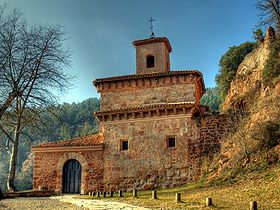- Monasteries of San Millán de la Cogolla
-
San Millán Yuso and Suso Monasteries * UNESCO World Heritage Site
Country Spain Type Cultural Criteria ii, iv, vi Reference 805 Region ** Europe and North America Inscription history Inscription 1997 (21st Session) * Name as inscribed on World Heritage List
** Region as classified by UNESCOThe monasteries of San Millán de Suso and San Millán de Yuso are two monasteries situated in the village of San Millán de la Cogolla, La Rioja, Spain. They have been designated a World Heritage Site by UNESCO.
The two monasteries' names Suso and Yuso mean the "upper" and the "lower" in archaic Castilian , respectively. Suso is the older building and is believed to be built on the site of a hermitage where Saint Emilian (Spanish: San Millán) lived. Perhaps Suso's major claim to fame is as the place where phrases in the Spanish and Basque languages were written for the first time.[1] The phrases in Spanish and Basque are glosses on a Latin text and are known as the Glosas Emilianenses. There is some debate as to whether the Spanish words are written in an early form of Castilian or in a related dialect. In either case, San Millán's importance as a cradle of the Spanish language is reinforced by the proximity of the village of Berceo which is associated with Gonzalo de Berceo, the first Spanish poet known by name.
There is a continuous history of Christianity at San Millán since the time of the saint. The scriptorium remained active during the period of Muslim rule; and over the centuries, the religious community has overcome various vicissitudes which affected the monasteries (for example being sacked by the Black Prince). However the type of monastic life evolved: the original monks living at Suso were hermits, but Yuso, the refoundation of the monastery on a lower site, developed as a Benedictine community. As the UNESCO evaluation noted, San Millán shows the transformation from an eremetic to a cenobitic community in material terms.[2]
Suso monastery has been uninhabited since the Ecclesiastical Confiscations of Mendizábal in the nineteenth century. Yuso monastery was also abandoned for some years in the nineteenth century, but was reoccupied. It houses an Augustinian community, but part of the monastery has been converted into a hotel. Today San Millán attracts pilgrims on the Way of St James (even though it lies somewhat off the line of the official route between Nájera and Burgos).[3][4]
 Sacristy of Yuso Monastery.
Sacristy of Yuso Monastery.
 Mozarabic arches in the Suso Monastery.
Mozarabic arches in the Suso Monastery.
Notes
- ^ The codex in question was subsequently preserved in the monastery library at Yuso before being moved to its current location in Madrid. See Glosas Emilianenses.
- ^ Entry on the World Heritage website.
- ^ route map
- ^ (Spanish) Cervantes Centre
References
- http://www.monasteriodeyuso.org (Spanish)
- w:es:Monasterio de San Millán de Suso
- w:es:Monasterio de San Millán de Yuso
World Heritage Sites in Spain For official site names, see each article or the List of World Heritage Sites in Spain.North West Caves of Altamira and Paleolithic Cave Art of Northern Spain1 · Monuments of Oviedo and the Kingdom of the Asturias · Roman Walls of Lugo · Route of Santiago de Compostela1 · Santiago de Compostela · Tower of Hercules
North East Caves of Altamira and Paleolithic Cave Art of Northern Spain1 · Mudéjar Architecture of Aragon · Pyrénées - Mont Perdu2 · Rock-Art of the Mediterranean Basin on the Iberian Peninsula1 · Route of Santiago de Compostela1 · San Millán Yuso and Suso Monasteries · Vizcaya Bridge
Community of Madrid Aranjuez Cultural Landscape · El Escorial · University and Historic Precinct of Alcalá de Henares
Centre Archaeological Ensemble of Mérida · Archaeological Site of Atapuerca · Ávila with its Extra-mural Churches · Burgos Cathedral · Cáceres · Cuenca · Las Médulas · Rock-Art of the Mediterranean Basin on the Iberian Peninsula1 · Route of Santiago de Compostela1 · Salamanca · Santa María de Guadalupe · Segovia and its Aqueduct · Toledo · Prehistoric Rock-Art Sites in the Côa Valley and Siega Verde
East Archaeological Ensemble of Tarraco, Tarragona · Catalan Romanesque Churches of the Vall de Boí · Ibiza (Biodiversity and Culture) · Palau de la Música Catalana and Hospital de Sant Pau, Barcelona · Palmeral of Elche · Poblet Monastery · Rock-Art of the Mediterranean Basin on the Iberian Peninsula1 · Silk Exchange in Valencia · Works of Antoni Gaudí
South Alhambra, Generalife and Albayzín, Granada · Cathedral, Alcázar and Archivo de Indias, Seville · Córdoba · Doñana · Renaissance Monuments of Úbeda and Baeza · Rock-Art of the Mediterranean Basin on the Iberian Peninsula1
Canary Islands 1 Shared with other region/s · 2 Shared with FranceCategories:- Augustinian monasteries in Spain
- Benedictine monasteries in Spain
- Monasteries in La Rioja
- World Heritage Sites in Spain
Wikimedia Foundation. 2010.
